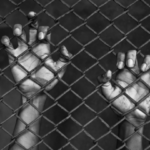Violent cycles: Homelessness and Crime

Around 105,000 people are experiencing homelessness or housing stress in Australia – with Streetsmart estimating that 1 in 200 of us won’t have a home to go to tonight.
The experience of homelessness has both long-term and wide-ranging consequences, often leading to contact with the criminal justice system.
Homelessness and Crime
Homelessness is recognised as a factor which often lead to criminal behaviour, yet we know surprisingly little about the link between homelessness and crime in Australia.
Research suggests many homeless people have had histories of violent or sexual abuse. But sadly, public policy often treats homeless people as perpetrators of crime, rather than victims.
Victims or Criminals?
Although there is often a link between homelessness and crime, there are complex factors that impact upon whether a particular person turns to crime. People often become involved in “survival crime” after becoming homeless, committing property offences to support themselves.
To further complicate the picture, a lifetime of trauma leading to homelessness and living a vulnerable life on the streets makes people more prone to substance abuse and mental health problems.
The Australian Institute of Criminology’s (AIC) Drug Use Monitoring in Australia program (DUMA) has been recording information relating to homelessness since 1999. The early data shows that a whopping one in ten people apprehended by police were homeless at the time of arrest.
DUMA recently expanded its survey to capture a broader view of homelessness, including housing stress. This suggests that massive 22 per cent of police detainees were experiencing homelessness prior to arrest.
The study also found that around one in ten police detainees are not confident they will have anywhere to live when once released, which minimises the impact of any rehabilitation services they may have been connected with as a result of arrest.
The AIC drew on these results to conduct groundbreaking research examining the factors underlying homelessness among Australian police detainees. It found a diversity range of reasons for homelessness, and that an individual, tailored approach to address underlying issues is important in reducing crime.
Dr Catherine Robson’s report Rough Living: Surviving Violence and Homelessness explores the experiences of six men and six women through a series of in-depth interviews over a three-month period. She concludes that despite common perceptions of homeless people as drug addicted criminals, people who are homeless are far more likely to be victims of crime than perpetrators.
Wide Ranging Issue
Homelessness affects people of all ages and backgrounds. Those living with mental illness or disability, Aboriginal and Torres Strait Islander peoples, the LGBTI community, and people leaving prison are most vulnerable.
And the Australian Human Rights Commission reports that the number of families with children and older women reaching out to homelessness services is steadily increasing.
Homelessness and Crime
The AIC’s findings suggest that a disproportionate number of homeless people have a criminal history, their crimes are normally less-serious in nature.
Living in public spaces, people who are homeless are more susceptible to committing public order offences like trespassing and public urination.
Those struggling to survive living rough often report they have no choice but to participate in crimes like shoplifting and squatting, and that they have always used drugs to cope with trauma, which leads them to commit other crimes to support their addiction.
The AIC’s study acknowledges that “police may specifically target homeless populations because of perceived community safety issues, or because homeless populations are more visible to street policing operations.”
Those who were arrested and reported experiencing homeless had a range of reasons for becoming homeless in the first place. From most common to least common, their answers were:
- Family/relationship breakdown
- Financial circumstances/job loss
- Drug problem
- Property eviction
- Court or justice order
- Alcohol problem
- Domestic violence
- Lack of family or social support/death of a family member
- Recent arrival (no means of support)
- Mental health problem
- Gambling problem
- Can’t explain
They described varied living situations for the 30 days prior to their arrest, including:
- Living in someone else’s house or apartment temporarily
- Shelter or emergency housing
- Prison
- Halfway house
- Drug or alcohol treatment program
- Hospital or psychiatric hospital
- On the street with no fixed address
- Long grass
Homeless and Non-Homeless Offenders
The AIC’s data suggests that there are important differences between homeless and non-homeless people arrested by police.
While over 80 per cent of people detained by police are male, for people who are homeless, the gender balance is roughly half/half. Homeless detainees were found to be a little older, more likely to have had a history of criminal behaviour, and more likely to test positive for drugs when arrested.
Two thirds were reported to have been drinking alcohol prior to their arrest.
Addressing Underlying Issues
Around half of Sydney’s homeless are likely to have been a victim of violence in the last year.
Australian Bureau of Statistics figures suggest that only 5 per cent of people living in NSW with stable accommodation reported experiencing violence within the same time frame.
In the context of a traumatic home life followed by a dangerous life on the street, it is possible to see how homeless people become involved in crime.
Addressing the underlying issues that lead to homelessness – including sexual trauma, drug and alcohol abuse, and various mental health issues – and providing housing support to these vulnerable people is crucial to reducing rates of crime, which ultimately benefits the whole community.






